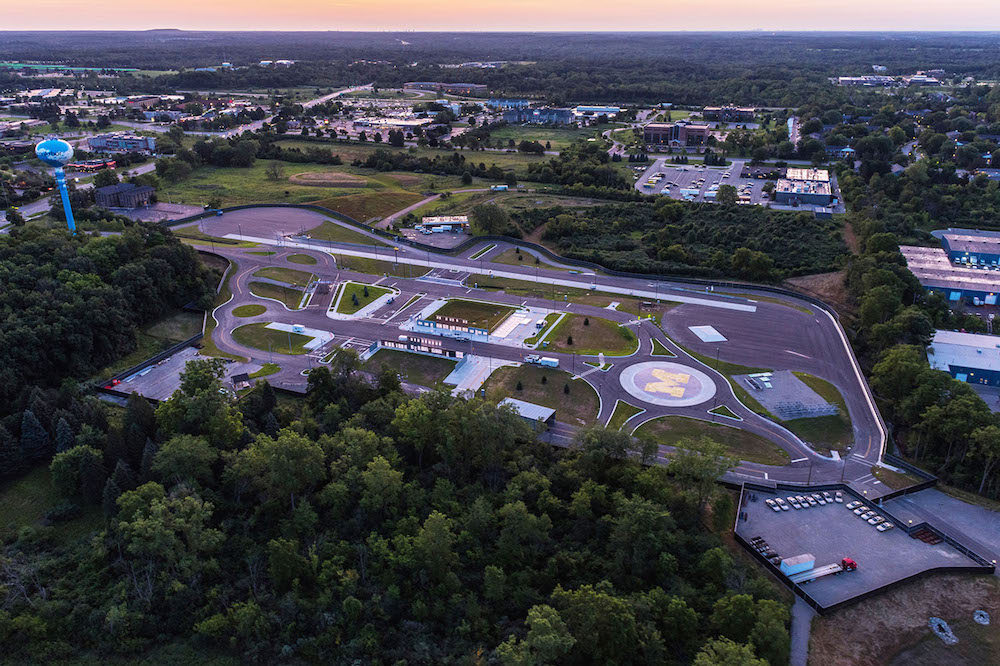If robomobili communicate with each other, then they become even safer.

In the virtual city, Mcity at the University of Michigan continues to experiment with modeling the future, in which most cars on the roads will be unmanned. In such circumstances, the main threat to safety will be those remaining archaic cars that are still driven by people. You need to be prepared for the fact that they will behave aggressively on the road surrounded by UAVs, sharply rearrange themselves, exceed speed, slow down sharply, drive through a red light, crash into poles , etc. Researchers are now modeling various situations when man appears bespredelschik. They found that it is possible to significantly improve road safety in such conditions if unmanned vehicles communicate with each other. By combining them into a single network, we significantly increase the overall "intelligence" of the system.
Engineers give some examples of typical situations that were experienced at the Mcity training ground. For example, a car with a man-driver rushes to the intersection where the red light is on. On the other side of the intersection, a stream of cars is approaching, the first of which is driven by an unmanned Lincoln MKZ. It burns green, and in front of the cameras and the lidar of this car is an absolutely clean intersection that can be passed. However, he does not do this, but slowly slows down - and gives way to the intruder, who suddenly appears because of the turn.
Another example. The car stopped abnormally and blocked the road immediately behind the "blind turn." However, the Kia Soul, which was racing behind, begins to slow down just before the turn, when the emergency vehicle had not yet appeared in sight. She does not even apply emergency braking, but gradually lowers the speed and stops on the side of the road even before the passengers saw the obstacle.
')
These are two examples of how communication between cars dramatically improves safety on the roads.
The mentioned Lincoln MKZ and Kia Soul are unmanned research vehicles united into a common network. Autopilots of these cars make decisions, taking into account the information that comes from other cars and from the infrastructure on the road. “We believe that connectivity and automation together provide the greatest potential to make transport safer, as well as reduce fuel consumption and allow people who have little or no opportunity to use it to use cars today,” says Carrie Morton (Carrie Morton ), deputy director of Mcity, a public-private partnership that studies the transport of the future.
The communication system between cars is traditionally called V2V (vehicle-to-vehicle). The idea is completely understandable. Car cameras and lidars are the eyes of the car, but they cannot see the obstacle and assess the traffic situation behind a blind turn, behind a fence, behind trees, outside the view of the devices. V2V technology makes a difference. In a single network, cars exchange wirelessly protected channels with information about their location, direction and speed. Up to 10 messages per second are transmitted over Dedicated Short Range Communications or DSRC channels.
It is much more reliable if the car also receives information from traffic lights on the radio, and does not focus only on the camera signal. The traffic light can shine or be poorly visible, but the radio signal does not exactly mix colors. In addition, by V2V, you can pass the time that remains until the traffic light changes, so the car quietly plans its further actions.
A variety of driving situations using V2V are now being tested at the Mcity training ground. In addition to real cars, virtual “ghosts” drive along the roads. Engineers have developed a special augmented reality system to fill the roads with virtual car traffic and thus make the tests more realistic. By the way, not only virtual cars drive here, but even there is one virtual train. All of them are connected to a single V2V network, so there is no difference for unmanned vehicles, whether a real car or a virtual car is traveling nearby. For researchers, this is an opportunity to test unique scenarios in action that would be too expensive to check in reality when the roads are filled with heavy traffic.

The Mcity test site is a 13-hectare modeled urban and suburban environment, where you can check the most dangerous scenarios before releasing unmanned vehicles in the “wild” conditions of these cities. Since opening in 2015, more than 65 industry representatives have joined the Mcity project, and its technological capabilities are increasing every year. The same augmented reality system was added last year. Some experiments are conducted under the open source free license. For example, the Lincoln Open CAV (Connected and Automated Vehicle) autopilot is released on an open source platform.
Although unmanned vehicles promise to dramatically improve safety on the roads, they still need to check out billions of kilometers in test mode and work out a lot of dangerous scenarios before such cars fully allow on all public roads.
Source: https://habr.com/ru/post/373579/
All Articles